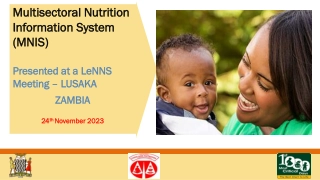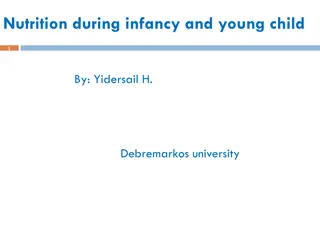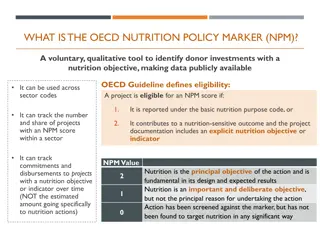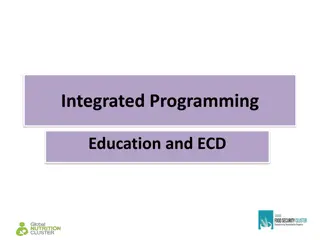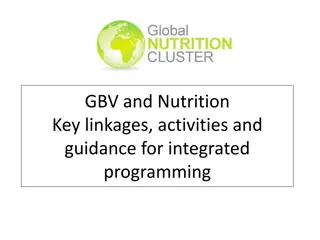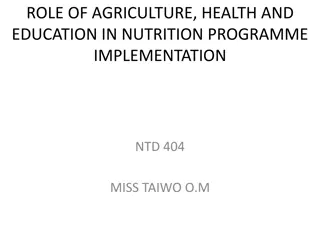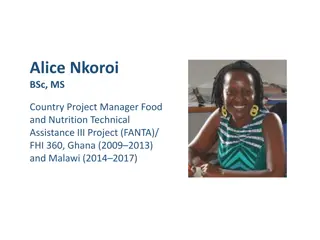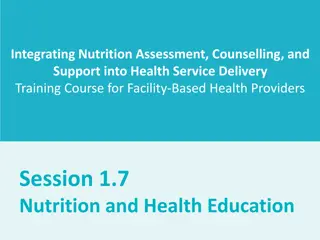
Nutrition Education: Objectives, Definitions, and Importance
Explore the world of nutrition education with insights on its definition, objectives, factors affecting food consumption, and the importance of promoting healthy eating habits. Gain a deeper understanding of nutrition requirements, the role of food in meeting body needs, and the aim of nutrition education in improving overall health and well-being.
Download Presentation

Please find below an Image/Link to download the presentation.
The content on the website is provided AS IS for your information and personal use only. It may not be sold, licensed, or shared on other websites without obtaining consent from the author. If you encounter any issues during the download, it is possible that the publisher has removed the file from their server.
You are allowed to download the files provided on this website for personal or commercial use, subject to the condition that they are used lawfully. All files are the property of their respective owners.
The content on the website is provided AS IS for your information and personal use only. It may not be sold, licensed, or shared on other websites without obtaining consent from the author.
E N D
Presentation Transcript
Nutrition Education Nutrition Education Prof. Ashry Gad Mohamed Prof. of Epidemiology College of Medicine, KSU
Objectives At the end of the lecture you should gain the ability to: Define nutrition. Know of aims of nutrition education. Understand factors affecting food consumption. Understand of channels and techniques of nutrition education.
Definition of nutrition education It is the science of teaching the individual how to practice proper and correct nutrition in terms of: 1-Knowing the proper nutrition rules. 2-Knowing benefit of each nutrient. 3-To give more attention to quality and quantity of foods. Nutrition:The process by which the human intakes food for growth, energy, and replacement of tissues; its successive stages include digestion, absorption, metabolism, and excretion.
Food: Any substance taken into the body that will help to meet the body needs for energy, maintenance and growth. Nutrition requirements: The quantities of each nutrient which met the human body needs to prevent nutrients deficiency diseases.
Contribution differs between countries Diseases Poverty Ignorance Malnutrition
Importance of nutrition education Importance of nutrition education Man doesn t have instinct nor inherit knowledge that leads him to know the effect of different foods on health. there is consensus that people s food choices, dietary practices, and physical activities behaviors influence health. increased risk of chronic diseases. nutrition education can increase the motivation, skills, and opportunities for people to engage in health promoting actions.
Aims of nutrition education Aims of nutrition education To increase people s ability to know the following facts: The relationship between the body growth, qualities of and appearance, and the types of food they eat. Increased diversification in the food they eat, and enjoy its taste. Planning and preparing of meals rich in nutrients.
The natural resources of food. Assessment of their nutritional behaviors and beliefs. Appreciating the importance of the standard of living improving programs.
Factors affected on human's food consumptions: Factors affected on human's food consumptions: 1-The health and disease. 2-Psychological factors. 3-Food habits. 4-Economic levels. 5-Education level. 6-Religious beliefs. 7-Political conditions.
8-Social conditions 9-Form and offering way of food 10-Media 11-Travel & Tourism 12-Labor Migration 13-Geographical characteristics 15-Religious occasions
Nutrition Education strategy Encouraging the targeted population to consume Balanced diets according to the: available sources Renew the dishes Local food and eating habits The presenting ways The best preparing Methods Suitable food To Meet the needs
Changing the eating habits through nutrition education Changing the eating habits through nutrition education Food habits affect food consumption pattern. Requirements: Diffusion Of Innovations : Spread of innovations / (new ideas). Communication process: Methods of conveying thought and feeling, it describes interactions between individuals and groups as well on between various media and people. Source : nutrition educator
Channel: presentations, lectures.media Message: simple (eat more vegetables and fruits) complex (how to get your child to eat healthful) Audience : individual, group or public.
Adoption of Idea Adoption of Idea Steps Awareness. Recognizing innovative for the first time Interest. Collection of information available about the idea as much as possible, and more knowledge about characteristic , as a result of generating motivation to learn more about this new idea.
Decision & evaluation. The adopter take decision continuing to collect more information about the idea or to quit , as well as begin to assess the information which obtained according to the present situation and future prospects for decision to adopt it , or leave it. Trial. In this stage the individual try to apply the new ideas in small area , to esteem the benefits of this new ideas. Adoption After recognizing and after convicting the benefits of the new ideas , the person will adopt these new ideas
Classes of adopters Classes of adopters Innovators Early adopters Early majority late majority laggards
Classes of adopters 40 30 20 10 0
Choosing the channels of nutrition education 1.Newspapers and publications. 2. The radio. 3. Television. 4. Space stations. 5. Telephone and fax. 6. Internet
Techniques Techniques ways that the educator will delivering the massages to the reserve (target groups) 1.lecture 2. seminars. 3. symposium . 4. role play 5. Discussion groups
References: References: El-Shafi M. Nutrition education. Educational course. CHS456. KSU. Park K. Nutrition and health. In: Preventive and social Medicine. Editor. 21th edition. 2011 pages 561-617.




